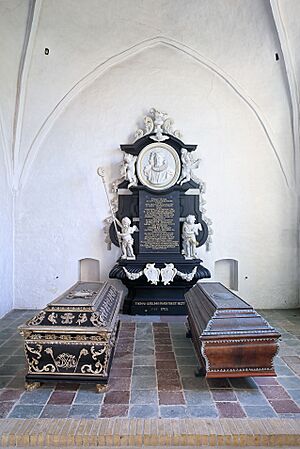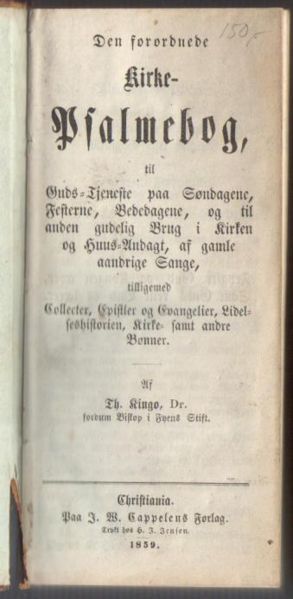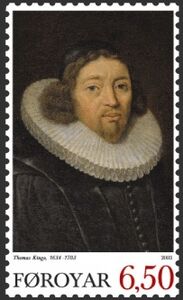Thomas Kingo facts for kids
Quick facts for kids Thomas Kingo |
|
|---|---|
 |
|
| Church | Church of Denmark |
| Diocese | Diocese of Funen |
| In Office | 1677–1703 |
| Predecessor | Niels Hansen Bang |
| Successor | Christian Rudolph Müller |
| Personal details | |
| Born | 15 December 1634 Slangerup, Denmark |
| Died | 14 October 1703 (aged 68) Odense, Denmark |
| Education | University of Copenhagen |
Thomas Hansen Kingo (born December 15, 1634 – died October 14, 1703) was a famous Danish bishop, poet, and writer of hymns. He was born in Slangerup, a town near Copenhagen. His writings are considered a high point of Danish baroque poetry.
Contents
Early Life and School
Thomas Kingo's parents were Hans Thomsen Kingo and Karen Sørensdatter. His father was from Crail, Scotland. He moved to Helsingør, Denmark, when he was only two years old. His father worked as a weaver, which means he made cloth.
The name Kingo is a shorter version of the Scottish name Kinghorn. Even though his family was not rich, Thomas went to Frederiksborg Latin School when he was 16, in 1650. Later, he studied theology (the study of religious faith) at the University of Copenhagen. He started there in 1654 and finished his studies in 1658.
Kingo's Career Path
Kingo began his career by teaching privately at Frederiksborg Castle. From 1659, he lived at the Vedbygård estate near Tissø. It was here that he wrote some of his very first poems.
In 1661, he became a chaplain (a type of minister) for priest Peder Worm. This was in Kirke Helsinge and Drøsselbjerg. Then, in 1668, he became a minister in his hometown of Slangerup. This is where he really started writing many poems. In 1677, Thomas Kingo was chosen to be the bishop of the Diocese of Funen. A bishop is a high-ranking church leader.
Famous Poems and Hymns
At first, Thomas Kingo wrote poems about his country. But later, he mostly wrote hymns. Hymns are religious songs or poems. In 1674, the first part of his book called Aandelige Siunge-Koor ("Spiritual Song Choir") came out. The second part was published in 1681. This book is a collection of hymns. Many of these hymns are still sung today in the Church of Denmark.
The government asked Kingo to create a new hymnbook. He put together what is now known as Kingo's hymnal (Kingos Psalmebog). This book came out in 1699. It includes 85 of his own hymns. This hymnal is still used in some parts of Denmark and Norway.
Some people in the Danish countryside really loved his hymns. They kept singing them even when other styles of music were popular. This helped Kingo's hymns survive for a long time. The same happened in the Faroe Islands. His hymns were widely used there for most of the 1900s. They were often sung to complex folk melodies. These melodies can often be traced back to Kingo’s own music collection from 1699. The original copies of his hymnals are kept at the National Library of the Faroe Islands.
Thomas Kingo was not the first Danish hymn writer. But he is seen as the most important one from his time. He is a leading figure among Danish poets of the 1600s. His hymns often show strong feelings. They can be about giving up worldly things or having faith and trust in God. He was also known for being careful with money and having a strong personality. His other poems are sometimes long. But his shorter works are very good. For example, his poem about the naval hero Niels Juel is simple and powerful.
His Personal Life

Kingo's first wife was Sille Blackenborg. He wrote a poem for her called "Chrysillis, mit Hjeertes Guld". She passed away in 1670, just one year after they got married. She had been the wife of the priest of Kirke-Helsinge before. His second wife was Johanne Lauritsdatter Lund. She was 13 years older than him. His last wife was Birgitte Balslev. She was 30 years old when Kingo, who was 60, married her in 1694.
In 1679, he was given a special honor, becoming part of the nobility. In 1682, he earned his doctorate degree in theology. He was also named a 'councilor of justice' (justitsråd) in 1690.
In his later years, Kingo had a skin condition that bothered him. He died in Odense in 1703. He is buried in Fraugde Kirke, a church outside of Odense. A sculptor named Thomas Quellinus designed a special monument and a metal screen for Kingo's burial place in the church. The screen was made by two smiths from Odense, Hans Hansen or Hans Hermansen. This screen was later moved to another burial chapel in the church.
Today, there are statues and places named after Thomas Kingo. An 1874 statue of Kingo by Theobald Stein is on the north side of St. Knud's Cathedral in Odense. Another statue from 1911, made by Viggo Jarl, stands outside Frederick's Church in Copenhagen. Thomas Kingo's Church in Odense and the street Kingosgade in Copenhagen are also named to honor him.
Gallery
Selected Works
Hymns
The website salmer.dk lists these hymns by Kingo:
- "Sorrig og glæde de vandre til hobe" (1681, 7 stanzas, 2 melodies)
- "Far verden far vel" (1681, 1899, 9 stanzas, 2 melodies)
- "Nu kom der bud fra englekor" (1689, 1852; 6 stanzas, 1 melody)
- "Nu rinder solen op" (1674, 8 stanzas, 2 melodies)
- "Kom, sandheds Ånd, og vidne giv" (1699 1864, 4 stanzas, 1 melody)
- "Den klare sol går ned, det kvælder mer og mer" (1674, 7 stanzas, 1 melody)
- "Som den gyldne sol frembryder" (1689, 9 stanzas, 1 melody)
- "Se hvor nu Jesus træder" (1689, 1845; 10 stanzas, 2 melodies)
- "Tak for al din fødsels glæde" (1689, 1845; 1 stanza, 1 melody)
- "Lad tidens hjul omdrive" (1689, 1857; 2 stanzas, 1 melody)
- "Skriv dig, Jesus, på mit hjerte" (1689/1844, 1 stanza, 1 melody)
- "Op, glædes alle, glædes nu" (1689, 3 stanzas, 2 melodies)
- "Rind nu op i Jesu navn" (1674, 7 stanzas, 1 melody)
- "Rettens spir det alt er brækket" (1689, 5 stanzas, 1 melody)
- "Gak under Jesu kors at stå" (1689. 1832-45 1951; 16 stanzas, 1 melody)
- "Vågn op og slå på dine strenge" (1674, 5 stanzas, 1 melody)
- "Fra verdens morgenstund udgår" (1689, 1854, 1951; 5 stanzas, 1 melody)
- "Nu nærmer sig vor pinsefest" (1699, 11 stanzas, 2 melodies)
- "Søde Jesus, Davids rod" (1689, 1868; 1 stanza, 1 melody)
- "Hvor stor er dog den glæde" (1689, 6 stanzas, 2 melodies)
- "Far verden far vel" (original, 1681, 15 stanzas, 2 melodies)
- "Hører til I høje Himle" (1689; 8 stanzas, 1 melody)
- "O salig påskedag" (1689, 2 stanzas, 1 melody)
- "Nat, søvn og slum og seng, farvel" (1677, 7 stanzas, 2 melodies)
- "O Herre Gud din lære" (1689 1854, 4 stanzas, 2 melodies)
- "Op min sjæl thi sol er oppe" (1684, 4 stanzas, 1 melody)
- "Morgenrøden sig udstrækker" (1684, 6 stanzas, 1 melody)
- "Dig vandre vi så gerne med" (1689, 1853; 5 stanzas, 1 melody)
- "O Jesus, søde Jesus, dig" (1689, 3 stanzas, 2 melodies)
- "Mørket skjuler jorderige" (1689, 7 stanzas, 1 melody)
- "Op, Zion, at oplukke" (1689, 1857; 2 stanzas, 1 melody)
- "Min sol, min lyst, min glæde" (1689, 5 stanzas, 2 melodies)
- "O gode Gud, din kærlighed" (1699, 1853; 7 stanzas, 1 melody)
- "Det runde himlens stjernetelt" (1689, 1853; 6 stanzas, 1 melody)
- "Over Kedron Jesus træder" (1689, 8 stanzas, 1 melody)
- "O Jesus, gør det ved din Ånd" (1689, 1852; 6 stanzas, 1 melody)
- "O store Gud, din kærlighed" (1699, 7 stanzas, 1 melody)
- "Herre Jesus, kom at røre" (1699, 1850; 3 stanzas, 1 melody)
- "Hvor dejlig skal Guds kirke stå" (1699, 8 stanzas, 1 melody)
- "Længe haver Satan spundet" (1689, 1699; 7 stanzas, 1 melody)
- "Ingen højhed, ingen ære" (1689, 9 stanzas, 1 melody)
- "Sover I Hvor kan I sove" (1689, 7 stanzas, 1 melody)
- "Mig lyster nu at træde" (1689, 1844; 5 stanzas, 1 melody)
- "Farvel du hvilesøde nat" (1684, 5 stanzas, 2 melodies)
- "Fryd dig i Guds behag" (1589, 7 stanzas, 1 melody)
- "Hvor saligt var det ægtepar" (1689, 1854, 1890; 7 stanzas, 2 melodies)
- "Alle ting er underfulde" (1689, 5 stanzas, 2 melodies)
- "Store Gud og Frelsermand" (1689, 4 stanzas, 1 melody)
- "Søde Jesus, jule-fyrste" (1689, 1832; 6 stanzas, 2 melodies)
- "O Jesus, på din alterfod" (1681, 1852; 10 stanzas, 1 melody)
- "Enhver, som tror og bliver døbt" (1689, 1843; 3 stanzas, 1 melody)
- "Hvor lifligt er det dog at gå" (1689, 9 stanzas, 1 melody)
- "Hvad er det for en snekke" (1689, 1857; 5 stanzas, 2 melodies)
- "Luk øjne op, o kristenhed" (1689, 3 stanzas, 1 melody)
- "Så skal dog Satans rige" (1689, 7 stanzas, 3 melodies)
- "O Jesus, præst i evighed" (1689, 1850; 7 stanzas, 1 melody)
- "O søde Gud, din kærlighed" (1699, 1837, 1853; 7 stanzas, 1 melody)
- "O kæreste sjæl, op at våge" (1689, 6 stanzas, 1 melody)
- "Fra Himmelen hid til os ned" (1699, 5 stanzas, 1 melody)
- "Hvor kan jeg noksom skønne på" (1699, 1854, 7 stanzas, 1 melody)
- "Nu ved jeg vej til Himmerig" (1699, 6 stanzas, 1 melody)
- "Vær trøstig, Zion, Jesu brud" (1689, 6 stanzas, 1 melody)
- "Op, sjæl, bryd søvnen af" (1689, 7 stanzas, 1 melody)
- "O Gud, du ved og kender" (1681, 1935; 4 stanzas, 1 melody)
- "Aldrig er jeg uden våde" (1681, 1850; 6 stanzas, 2 melodies)
- "Tiden skrider, dagen rinder" (1684, 6 stanzas, 1 melody)
- "O Jesus, går du da din vej" (1699, 8 stanzas, 1 melody)
- "Lov og tak og evig ære ske dig" (1689, 3 stanzas, 1 melody)
- "Nu bør ej synden mere" (1699, 1890; 4 stanzas, 3 melodies)
- "Gud er Gud, før jorden skabtes" (1674, 1947; 2 stanzas, 1 melody)
- "Sorrig og elendighed" (1681, 27 stanzas, 1 melody)
- "O Jesus, du al nådens væld" (1699, 1951; 4 stanzas, 1 melody)
- "Min sjæl, om du vil nogen tid" (1699, 9 stanzas, 1 melody)
- "Vor Gud er idel kærlighed" (1699, 4 stanzas, 2 melodies)
- "Den nåde, som vor Gud har gjort" (1699, 4 stanzas, 1 melody)
- "Gud lade rolighed og fred" (1689, 1947; 3 stanzas, 3 melodies)
- "Dagen nu sin afsked tager" (1677, 4 stanzas, 1 melody)
- "Hvilestunden er i vente" (1684, 9 stanzas, 1 melody)
- "Til hvile solen går" (1674, 8 stanzas, 2 melodies)
- "Aftenstjernen hisset tindrer" (1684, 4 stanzas, 1 melody)
- "Det mulmer mod den mørke nat" (1674, 5 stanzas, 1 melody)
- "Se, hvor sig dagen atter skynder" (1674, 7 stanzas, 2 melodies)
- Children's hymns
- "Sorrig og glæde" (1681, 1 stanza, 1 melody)
- "Nu rinder solen op" (1674, 1 stanza, 1 melody)
Poems
- "Chrysillis"





